May 29, 2025 | 20:46 GMT +7
May 29, 2025 | 20:46 GMT +7
Hotline: 0913.378.918
May 29, 2025 | 20:46 GMT +7
Hotline: 0913.378.918
Yellow blossom glutinous rice is a well-known traditional specialty paddy of the Northern midland and mountainous regions, including Hai Phong, Hung Yen, Hai Duong, Quang Ninh, Bac Ninh, Bac Giang, and Hanoi.
Residents of various communes in the district of Tien Lang have kept the fragrant white rounded rice grains crediting to the mind and relentles efforts of generations on conserving the true paddy variety for today's progeny for years, with the exception of Hai Phong.
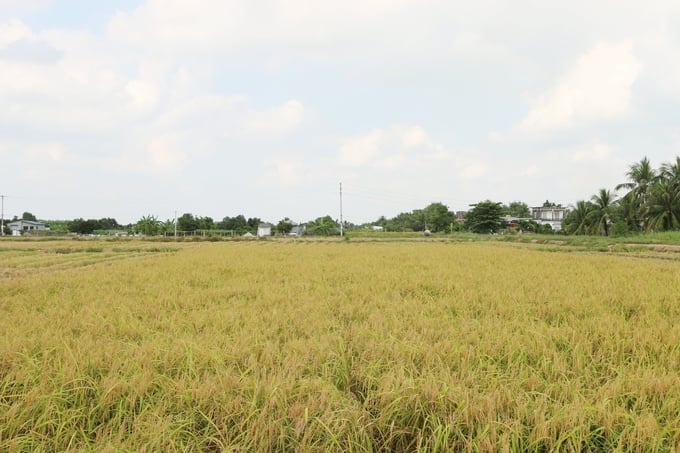
Yellow flower sticky rice field in Dai Thang commune, Tien Lang district in the 2023 season. Photo: Dinh Muoi.
20 years ago, the agriculture practice of the locals in Dai Thang commune of Tien Lang district was deemed the most old-school of its sort in the Northern area by a survey group when the formal only wanted to remain and plant local traditional yellow flower glutinous rice.
At the time, despite low yield of roughly 1 quintal per plot, local farmers stayed with this form of paddies rather than switching to alternatives given by specialized agencies that were shorter-day and produced more. Especially, since being recognized as a collective trademark by the Intellectual Property Office (Ministry of Science and Technology), the yellow flower glutinous rice in Dai Thang has been elevated to a new level.
"Selling yellow flower glutinous rice is very easy; traders come to the field to place orders, even when the rice is still green. As soon as we harvest, we can sell it immediately. This year, we sold it for up to 13,000 VND/kg of fresh rice. Surely, in the upcoming season, we will continue to plant 100% of yellow flower glutinous rice and maintain it regularly," shared Mrs. Pham Thi Son from Lang Nien hamlet, Dai Thang commune.
Yellow flower glutinous rice in Dai Thang has distinctive characteristics, with round, opaque white grains that are sticky and fragrant when cooked into sticky rice or used for making traditional cakes like banh chung. Among the areas in Tien Lang district where yellow flower glutinous rice is grown, the quality of rice in Dai Thang is considered the best. For the people of Dai Thang, rice cultivation is not just a profession but also a cultural heritage to preserve for future generations, ensuring the continuation of this special rice variety that may be exported to larger markets.
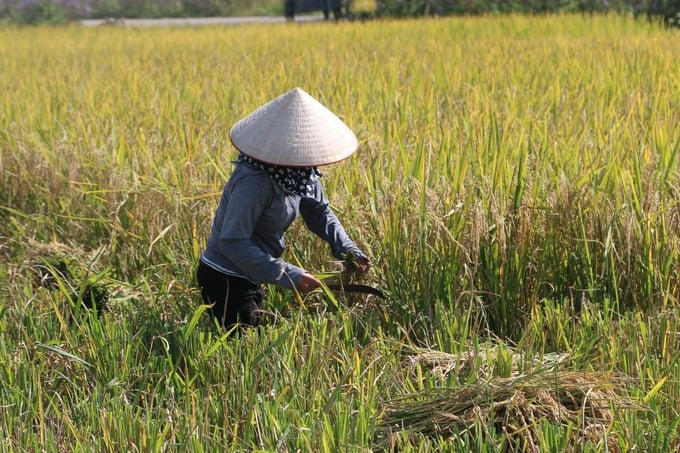
More than 90% of people in Dai Thang commune grow yellow flower sticky rice. Photo: Dinh Muoi.
Due to the advantage of flat and spacious fields, enriched by sediment from the Van Uc River and Mia River throughout the year, the soil in this area is fertile, suitable for producing yellow flower glutinous rice. This is the reason why the yellow flower glutinous rice from Dai Thang differs from products produced elsewhere. And it is also for this reason that the cultivation area for yellow flower glutinous rice in this region has remained stable for many years.
Mr. Nguyen Van Ngoc, Director of the Dai Thang Cooperative, stated that there are currently more than 1,000 households cultivating yellow flower glutinous rice, covering a total area of over 282 hectares, equivalent to over 90% of the agricultural land in the commune. The average yield is around 56 tons/ha.
"We will continue to promote the production of yellow flower glutinous rice, which is the local strength, while further improving the quality in accordance with the VietGAP process to enhance the value chain of this rice variety," affirmed Mr. Ngoc.
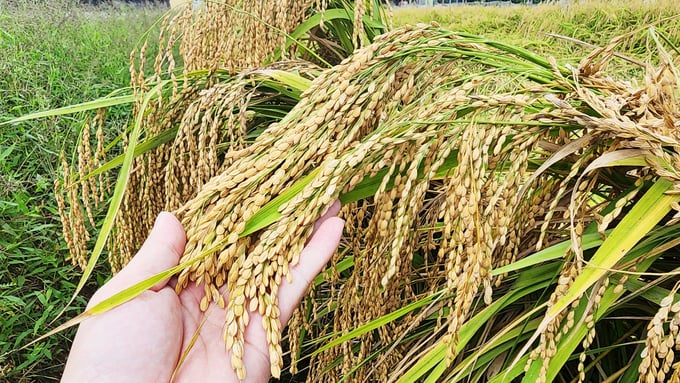
Yellow flower sticky rice in Dai Thang commune is characterized by round, opaque white grains, sticky and fragrant. Photo: Dinh Muoi.
The yellow flower glutinous rice in Dai Thang reaches a height of approximately 150-155cm, featuring sturdy plants with broad roots and stems that resist falling relatively well. This rice variety exhibits tolerance to alkali, acidity, and submersion, performs reasonably well under late-season drought conditions, and shows good resistance to diseases such as blast and bacterial blight, although it is susceptible to stem borers.
The growth cycle of this rice spans up to 160 days, making it suitable for seasonal cultivation. Therefore, selecting high-quality seeds is crucial, ensuring they are robust, uniform in size, free from contamination with other varieties or weed seeds.
After harvesting, farmers follow a meticulous drying process, exposing the rice to sunlight in the morning and then allowing it to sweat in the afternoon. During drying, the rice is regularly turned to ensure even exposure. Once dried, the rice is cleaned, and fans are used to remove impurities before being packaged for storage in dry conditions.
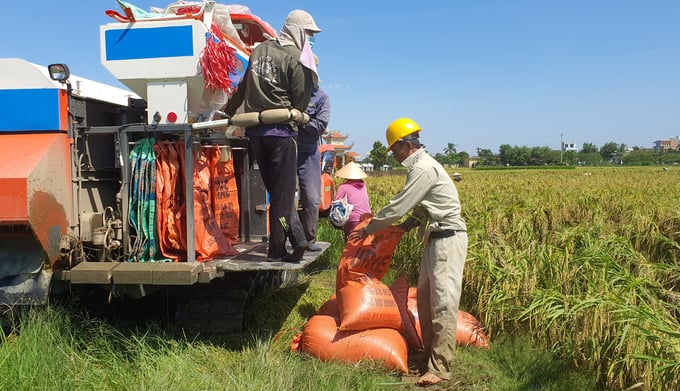
In the 2023 season, yellow flower sticky rice is sought after by traders and purchased in the field at a price of 13,000 VND/kg. Photo: Dinh Muoi.
According to the Hai Phong Promotion Center for Agriculture, the yellow flower glutinous rice in Dai Thang is identified as a native, pure Vietnamese rice variety that has been preserved for many generations. Recognizing the importance of this rice variety, Dai Thang commune and Tien Lang district have focused on building large fields with modern and safe production processes, enabling the unique local product to reach markets beyond.
To support the local community in achieving this goal, scientists have collaborated to research and apply technical measures and farming practices to enhance the yield of yellow flower glutinous rice. The entire production process, from input material management to planting, caring, harvesting, and storage, is meticulously documented and stored.
Initially, when introducing new technical measures, the local farmers were hesitant and skeptical. For instance, the use of fertilizers, applying the border-effect planting technique, or adopting integrated pest management strategies required continuous on-field investigations rather than routine pesticide spraying.
Scientists have refined the yellow flower glutinous rice production process to meet VietGAP standards and have transferred this knowledge to the local farmers. Through these efforts, rice productivity has significantly improved, providing local farmers with higher incomes and the means to further develop this special rice variety.

Coming to Dai Thang during the harvest season, everywhere I saw sticky rice drying yellow flowers. Photo: Dinh Muoi.
Mrs. Pham Thi Son from Lang Nien hamlet (Dai Thang commune) shared that since this rice variety has been in existence for a long time, the community had a deep understanding of it. Initially, there was skepticism about the new technical guidance, but after implementing the recommended farming practices, rice productivity improved noticeably.
Mr. Mai Hoa Giang, Chairman of the People's Committee of Dai Thang commune, emphasized that in recent years, the widespread adoption of mechanization and scientific technology in production has led to significant improvements. Local farmers now use machinery for various stages of cultivation, from planting to harvesting, reducing production costs, increasing productivity, and minimizing manual labor. Some households cultivate areas of up to 5 hectares of yellow flower glutinous rice, earning hundreds of millions of dong per crop.
As a distinctive and aromatic rice variety, the yellow flower glutinous rice in Dai Thang is sought after by consumers. In addition to the local Hai Phong market, it is also sold in other provinces and cities such as Hanoi, Ho Chi Minh City, Quang Ninh, and Hai Duong.
Translated by Linh Linh

(VAN) FAO’s Director-General addresses the 5th Baghdad International Water Conference.
/2025/05/26/1716-4-nongnghiep-191706.jpg)
(VAN) Chain linkages, technological innovation, and raw material zoning are three strategic pillars for the coconut industry to strongly develop and elevate its position on the global agricultural map.
![Advanced mariculture – an inevitable trend: [4] Accompanied by scientists](https://t.ex-cdn.com/nongnghiepmoitruong.vn/608w/files/sohk/2025/05/13/1941-pgsts-vo-van-nha-140958_717.jpg)
(VAN) According to Assoc. Prof. Dr. Vo Van Nha, Director of the RIA III, the development of advanced offshore mariculture is no longer an option but an essential path for Vietnam’s fisheries sector.
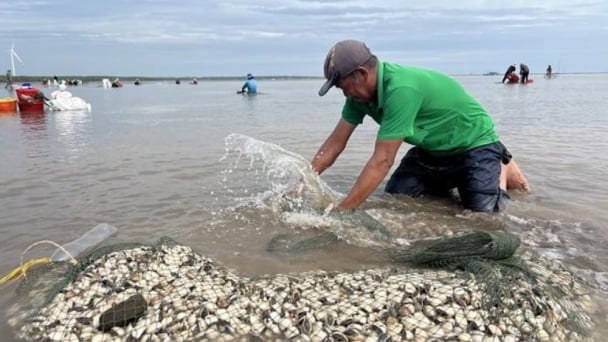
(VAN) Vietnam is intensifying the development of mollusk farming areas that meet international standards, aiming for sustainable growth and enhancing its export position in the global seafood market.
![Advanced mariculture – an inevitable trend: [3] Policy-driven momentum](https://t.ex-cdn.com/nongnghiepmoitruong.vn/608w/files/doanhtq/2025/05/21/0104-0616-0348-nuoi-bien-170339_789.jpg)
(VAN) To ensure the success of offshore mariculture that uses advanced technologies, it is essential to establish supportive policies that inspire both individuals and enterprises to invest with confidence.
![Advanced mariculture – an inevitable trend: [2] Outstanding results](https://t.ex-cdn.com/nongnghiepmoitruong.vn/608w/files/sohk/2025/05/12/4632-4136-nuoi-bien-11-164117_819.jpg)
(VAN) Pilot models of high-tech offshore mariculture in Vietnam, particularly in the South Central Coast region, have demonstrated exceptional economic returns and sustainability, setting a new direction for the country’s aquaculture industry.
![Advanced mariculture – an inevitable trend: [1] Moving offshore](https://t.ex-cdn.com/nongnghiepmoitruong.vn/608w/files/phucpm/2025/05/18/0252-2436-nuoi-bien-6-162148_783.jpg)
(VAN) Mariculture using advanced technology and moving offshore is an inevitable trend, as nearshore areas increasingly reveal limitations.